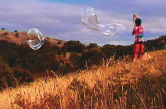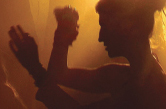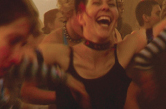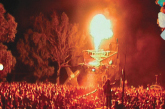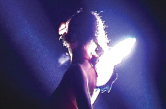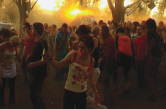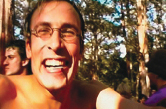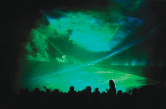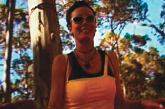
Short-Changed in Wonderland By Suzi Taylor
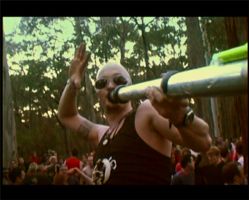
Pack your aerogard, glow sticks, angel wings, ear muffs, fluoro fluff and chuppa chups. We're off to Wonderland…..
James Short has travelled a very long way since studying law in Queensland and paying his way through uni by working on film shoots. In 2006 his film 'Welcome to Wonderland', an evocative feature-length film on bush rave culture in Melbourne, was released and distributed through music retail outlets around the country, and overseas. It's recently screened at the Byron Bay Film Festival and has been invited as the opener for the Media Wave Festival in Hungary at the end of April.
James filmed, directed and produced the film himself, along with supervising the edit, sound mix, animation, claymation and composition. 'My friends bought houses. I self-funded my doco' he explains with a smile. James had been to indoor raves, but it was only when he was 26 that a friend coaxed him along to a bush party - an experience which was a turning point for him personally, and creatively. 'It was such a liberating experience, it blew me away - dancing in the open air with 3,000 other people.' At the time, he had just completed a post grad in documentary film at the VCA, and knew immediately that there was a film in what he'd experienced. Being surrounded by other doco students meant that he had voluntary crew to call on for help, and the decrease in costs of technology meant that for the first time, doing it all independently was a real possibility. 'We were on the cusp of technological change in 2000, suddenly equipment became affordable. People told us you'll never make a feature before you're 40, and if you're doing a doco, it has to be either 30 or 50 minutes, to fit into SBS or ABC slots.' Instead, James decided that he'd create something and sell it out to the marketplace directly. Five years on, that's exactly what he's doing.
The process of bringing Welcome to Wonderland to fruition was to test every ounce of tenacity James had, fraught with challenges from the outset. The filming involved having to cope with 24 hour outdoor shoots, navigating dance floors of hedonistic ravers, trying to get party-goers to commit to turning up to on-site interviews and then scheduling them in such a way that there'd be no doof in the background. 'One thing I know is that filmmaking is all about perseverance. That's it. It's often the difference between films that get made and those that don't.'
162 hours of tape later, James had his raw footage, including 120 interviews and countless hours of footage from bush raves across Victoria. There was no script. There was no money. There was no broadcaster interest. There was no funding body interest. What followed was a solid two years spent on international fundraising, where James enlisted the help of a group of friends, along with his partner Clara, to draw on their various expertise in marketing and producing, to compile a 32 page marketing strategy. Most documentary directors would find this process hellish and while James admits to finding it confronting, adds that 'It was a good process to really consider the film from a business perspective.' Despite several promising leads, no international interest eventuated as most investors wanted creative control over the production. 'Red Bull came on board though, and paid us in fridges and drinks to take to bush parties!' Unfortunately, post-production crew could only be paid for so long in nutritious party drinks, so James made the leap and funded the rest of the film himself. The battle for funds was, extraordinarily, proceeded by a whole year spent in contractual negotiations with music companies, over music copyright. 'That's when entertainment law really came in handy!' James uses 62 pieces of music in the film and worked with 6 different composers.
Meanwhile, in the parallel universe to the economic and legal obstacles James was negotiating, there was a film to edit and a story to flesh out. Starting with no script, but many, many interviews, James set up a big corkboard in his room and literally cut and pasted chunks of interviews together, to find a shape and structure to the film. The painstaking process of transcribing and pasting drew James's attention to the strongest story that leapt out. Margaret was from the country originally, had married young, was divorced, overweight and uninspired. She went to her first bush rave and found a nurturing community characterised by creativity, fun and acceptance. She fell in love with the music and the culture, shed a bunch of kilos and lost her fear of dancing in public. The film follows a loose structure of a 24 hour bush party, and is peppered with anecdotes and reflections from five main characters, including Margaret. It's an unusual doco, in that it's neither character-driven nor plot driven. Instead, it's a highly sensual film that transplants you right down onto the dusty dancefloor, alongside hundreds of other dancers, below lasers, looming gum trees and jet-black skies. It carries you through until the sun comes up. James explains, 'The different characters become like vehicles, or inroads into that world - people and stories to identify with, even if the world itself is foreign to the viewer.'
Interestingly, James identified early on that a strong theme of the film was of dance as a means of empowerment, particularly for women. 'The thing about outdoor parties is that there is a realy strong female presence…..It's a place that seemed to turn the rest of the world's norms upside down - where females are strong, independent and confident on such a large scale, and it isn't about make up and heels. The beauty and power is in the movement and the self-expression'. It's a trajectory that James is familiar with. As a self-confessed non-dancer at the outset (I'm from Queensland. We go to pubs!'), his first bush rave represented something of a turning point in developing his own confidence, self-expression and perhaps ultimately, the kind of courage that would keep an otherwise level-headed and rational person on board such a tumultuous ride!
So from a corkboard of cut-outs, with the end in sight, James started working with editors Cindy Clarkson and Sioux Currie. With so much footage, they ended up cutting two separate feature-length films. They then took a 5 week holiday, returned to the edit suite, merged the two films into one and started the tinkering and polishing. This is one film that has been made with a lot of love, and James is one filmmaker who doesn't seem to do anything by halves. Once edited, he went on to employ artists to add animation and claymation into the film, build a stunning website and develop terrific DVD content.
Has it paid off? Mission accomplished? James smiles. 'I worked with an incredible, top production and post-production team and learnt so much.' James was both humbled and overwhelmed by the generosity of people who were drawn to his vision for the film. 'I was really surprised with the people who came on board to help, especially from the higher-end commercial world. They didn't need money, but they did need adventure. I think they were excited by the creative scope within this film.'
Towards the end, indie distributor Underground Epidemic Productions ('Melbourne Shuffler') came on board to help with back-end sales, getting the film in-store, so that it's now available in over 100 retail outlets Australia-wide, including Myer, HMV and JB HiFi. Web reviews and interviews have also helped generate sales from around the world. 'It's really big in South Africa and Europe, they've got a big trance culture over there!' James ends by saying, "I believe we have made a really good little film that people will hopefully support. Filmmaking is a really tough gig and I hope that we have created an experience that people will truly enjoy and continue to watch over the years."
